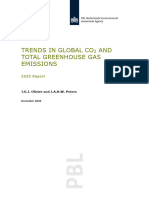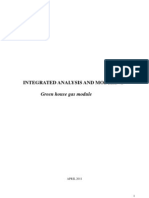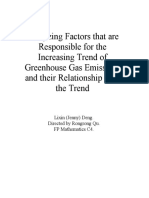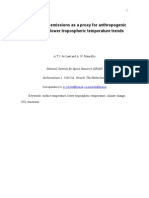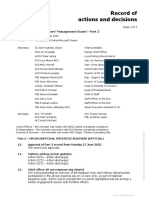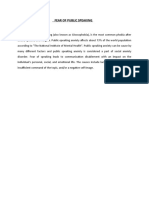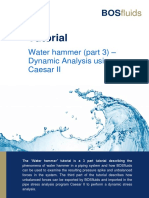Regression and Correlation Analysis To Model Future CO2 Emission and Temperature in Jakarta
Regression and Correlation Analysis To Model Future CO2 Emission and Temperature in Jakarta
Volume 8, Issue 12, December 2023 International Journal of Innovative Science and Research Technology
ISSN No:-2456-2165
Regression and Correlation Analysis to Model Future
CO2 Emission and Temperature in Jakarta
¹Kezia Stevani Gerrard Silalahi; ²Mikha Clementinus
SMAK 7 BPK Penabur Jakarta, Indonesia
Abstract:- This study aims to develop a methodical Keywords:- Carbon dioxide; CO2 emissions; Temperature;
approach to investigate the impact of CO2 emission Environmental; Climate change; Regression Analysis.
gasses on the temperature in Jakarta. Recently, the
anomaly of temperature and climate has been one of the I. INTRODUCTION
issues not understood by the public. People rely on
weather forecasts without knowing the image at all. In The anomaly of temperature and climate change is no
this research, an analysis of the data on CO2 emission longer a new thing because it is happening at the moment.
level and temperature is needed in order to design a non- Indonesia, as one of the tropical countries in the world, has
linear regression model that depicts the relationship experienced the effects of climate change as the temperature
between both variables. Moreover, the proposed in some cities is drastically increasing. This graph is an
methodological approach is intended to be widely spread overview of the temperature anomaly recorded by the
among the general public in order to understand the Indonesian Agency for Meteorological, Climatological, and
correlation and impact that CO2 emission gasses have on Geophysics.
environmental aspects, namely temperature and climate
change.
Fig. 1: Comparison of Average Temperature 1991-2020 and 2023
This study will focus on the changes happening in II. LITERATURE REVIEW
Jakarta, the capital city of Indonesia and one of the cities
with the highest surge in temperature. Therefore, this study This research emphasizes on the air temperature
aims to investigate the major cause of this phenomenon, predictions in the ever warming city of Jakarta. In order to
which is CO2 emission gasses. accurately predict the city air temperature, it’s needed to
determine the dominant factor that caused the increase of
This research involves the collection of data on temperature. Based on recent studies, H2O, and CO2 is the
temperature rates throughout the period 2022–2023 and most significant global warming contributor within the
CO2 emissions sources from combustion vehicles, power family of greenhouse gasses [30, 34]. This is due to those
plants, residential, and industrial emissions within and gasses that have a property of absorbing infrared radiation
surrounding Jakarta. The purpose of this paper is to develop on several bands [34]. Meanwhile, in the city of Jakarta,
a mathematical model as an approach to compare the there has been an increasing amount of industrialization, and
amount of CO2 emissions and temperature increase rate to land usage that has made the CO2 emissions increase
investigate the impact and the correlation between these two drastically [21, 22, 26]. Ever since the 19th century, the
variables. With the regression model discussed in this paper, levels of CO2 concentrations have increased by 40%.
we will be able to predict the possible effect and outcome Combining this rise of CO2, added with the growing
(in temperature) if the amount of CO2 emissions is concentrations of other greenhouse gasses (CH4, N2O, etc.),
increased or decreased. has led to the increase of global temperatures by a rate of
0.08 degrees celsius per year [30].
IJISRT23DEC1900 www.ijisrt.com 2401
Volume 8, Issue 12, December 2023 International Journal of Innovative Science and Research Technology
ISSN No:-2456-2165
Based on the significance of CO2 emissions, it is a A. CO2 Emission Prediction
possibility that the increase of temperature can be a local, or The property of CO2 that is used for the emission
regional phenomenon. This is possible due to the differences estimation is the mass of CO2 emissions, at a certain time
of CO2 concentration levels, and other factors that period.
contribute to the absorption, and emission rates of heat, The method used for predicting CO2 emissions that is
particularly from the sun, in different regions. This developed in this research is called yearly vehicle-based
possibility is confirmed in the form of Urban Heat Island emission percentage prediction (yearly VEPP). This method
(UHI) phenomenon. Where, urbanized areas, such as large refers to the Jakarta Bappeda [7] report about the
cities would have higher levels of greenhouse gasses percentage of emissions from the transportation sector,
emissions, and radiation absorption & re-emission rates, compared to the total CO2 emissions. Thus, the formula to
compared to more natural landscapes [20]. This predict the total CO2 emissions from the vehicle emission
phenomenon caused cities (highly urbanized areas) to have percentage is:
higher temperatures compared to the low-urbanized areas, or
more natural areas surrounding it. The percentage of emissions per category from Jakarta
Bappeda report in 2022 is 46% from the transportation
ZIn the megapolitan city of Jakarta, UHI regions can sector, 31% from power plant sector, 8% from the industrial
be defined as regions that have a temperature of more than sector, 6% from the residential sector, and 5% from the
30 degrees celsius. UHI in the city of Jakarta has a drastic garbage, and landfill sector [7].
increase rate in the 21st century. From 36,5% of Jakarta in
2008, 84,7% of Jakarta in 2013, and 93,7% in 2018 [24]. B. Vehicle Emission Calculation
The increase of UHI can be concluded as the increase of In order to predict the CO2 emissions from
temperature in the city of Jakarta. In this research, this transportation and vehicle sectors, we calculate the emission
increase of temperature could be observed synchronizes levels from the vehicle volume, vehicular emission rate per
with the increase of vehicle usage, and infrastructure in the distance, and the average traveled distance of a vehicle in a
city. Later on, this research will analyze the relationships
between the increase of CO2 emissions in Jakarta, and the
increase of temperature observed. The mathematical model
single day. This action is done by using this formula:
that is obtained from such regression would be used to
predict the temperature of Jakarta in future months.
The fundamental theorem that is used to calculate the
relation between CO2 emissions, and temperature is the M_CO2 : CO2 emission mass (grams)
radiative forcing phenomenon, where the atmosphere emits n : yearly vehicle volume
less radiation than it absorbs, and causes an increase of r : CO2 emission rate (grams/km)
temperature [34]. In which, the relation between CO2 and d :average daily distance traveled by a vehicle (km)
temperature is described by a logarithmic graph [6, 34].
Due to the proportional relation between CO2 and The CO2 emission mass is calculated on each different
temperature, the CO2 concentration and temperature data vehicle category, due to each unique respective volume
will be sorted from the lowest values, to the highest, before (count), emission rate, and daily distance traveled. The
being analyzed. vehicle category classification, and emission rate is based on
a 2023 vehicle emission research in Hangzhou, China [33].
III. METHODOLOGY Another emission rate value is obtained from an emission
distribution research in Tegal City, Indonesia [29]. The
The Jakarta temperature prediction model would need vehicle volume data used to calculate the total emissions is
three basic variables, including the temperature history, CO2 sourced from the BPS (Central Statistics Agency), and
emission estimation history, and the time period of the regional DKI Jakarta statistical data [2, 17, 31]. The
observed temperature & CO2 behavior. Which would then variables are portrayed in this table:
be calculated in order to obtain mathematical expressions
that are able to predict the average temperature of Jakarta, as
a function of CO2 emissions, in different time periods.
Fig. 2: Emission Rate of Vehicles
IJISRT23DEC1900 www.ijisrt.com 2402
Volume 8, Issue 12, December 2023 International Journal of Innovative Science and Research Technology
ISSN No:-2456-2165
Vehicle classification on this table is divided into 6 emission model to achieve the final mathematical model that
categories. Which include DHV, Daily Household Vehicles, predicts the temperature of Jakarta in the future. The results
and SPRV, Spare Vehicles (cars); LCV, Light Commercial would be a set of two mathematical models, one is
Vehicles (taxis); LDV, Light Duty Vehicles (pickups); HCV, temperature as a function of CO2 emissions which is the
Heavy Commercial Vehicles (buses); HDV, Heavy Duty result of previous observations and another is temperature at
Vehicles (trucks); motorcycles. DHV daily distance travelled a certain timeline, which uses the VEPP model for the CO2
will be used for motorcycle’s [33]. emission value, to predict the temperature of Jakarta in the
future.
The predicted CO2 emissions using VEPP would then
be compared to the CO2 emissions that are observed in a IV. RESULTS AND DISCUSSION
Greenpeace report [25].
A. CO2 Emission Analysis
C. Temperature and CO2 Emission Correlation The observed CO2 emission data has a range from 2010-
The relation between temperature and amount of CO2 2019. Meanwhile, the vehicle usage data for the VEPP
emissions would then be calculated using regression calculation has a range from 2010-2022. In plotting the
analysis. The temperature data used is sourced from Halim VEPP model with the real observation within the 2010-2019
Perdana Kusuma (HLP) International Airport weather range, the VEPP model has a significantly higher emission
station (East Jakarta) observations from 2010-2019 [16]. value. In order to synchronize the model, the difference of
Temperature data from Tanjung Priok weather station will value of CO2 emission between the VEPP and the real
also be used for data range within 2020-2021, and for 2019 observation is calculated from each year, and changed into a
data that was not available in the previous database [3].The percentage difference. The percentage difference from
temperature used is a monthly average. While in order to different years has an average value of 17.4%, a median of
calculate the relation between CO2 emission, and 14.7%, and a middle value of 8.6%. Subtracting 100% with
temperature, the observed CO2 emission within the range of this percentage results in the effective emission percentage.
2010-2019 would be primarily used. Then, for the After plotting the VEPP model with different effective
unobserved emissions of the future, emissions from the percentages, the model with the most analogous results is
VEPP model would be used. the median effective percentage. This VEPP model has
higher than real emissions in early years, near 2010. But, the
This research will provide various regression trend model has a more matching trendline with the real emissions
lines which include linear, logarithmic, exponential, 2nd, from the year 2016 onwards, with a value difference of less
and 3rd degree polynomials. The regression has an aim of than 400 Ton CO2 emissions.
getting the R squared value of more than 0.90. The obtained
regression variables would be combined with the VEPP
Fig. 3(a): the VEPP emission model (blue), plotted with the real observational data (orange). observational data is from 2010-
2019, with the later orange graph is the trendline of observational data. While the VEPP model is plotted from the available
vehicular data between 2010-2022.
IJISRT23DEC1900 www.ijisrt.com 2403
Volume 8, Issue 12, December 2023 International Journal of Innovative Science and Research Technology
ISSN No:-2456-2165
Fig. 3(b): the value of emission difference between the median-VEPP model, and the real observational data to measure accuracy
of the model.
B. CO2 concentration analysis Jakarta, from ground level, up to the stratosphere. The
The base relations between CO2, temperature, and stratosphere is set to be the boundary, due to the highest
radiative forcing, uses the CO2 in the form of concentration. radiative forcing effects that happen within the stratosphere,
To convert CO2 emission mass to concentration, we can use and troposphere beneath it [6].
the basic ppmv formula of
In order to calculate the atmospheric volume, the
atmosphere is modeled as the volume difference between
two 3D spherical sectors, with the same solid angle, but
different radius. The outer (higher radius) is a spherical
sector from the stratosphere to the center of the earth. While
C : CO2 concentration the inner (lower radius) is a spherical sector from the
M_CO2 : CO2 emission mass altitude of Jakarta to the center of the earth. The deflection
angle of the circular surface area on the sphere surface is
rho : CO2 density calculated from the area of Jakarta. The corresponding
V_air : volume of atmospheric air
formulas of the calculations are :
The air volume in this calculation refers to the volume
of the earth atmosphere above
By taking the area of Jakarta as 661.52 km^2 [1], the polynomial, 2nd degree polynomial, logarithmic, and
radius to the stratosphere as 6421 km (50 km above earth exponential, which results are interpreted in the four graphs
radius) [27], and the radius to the altitude of Jakarta as below, with the y-axis representing temperature, and the x-
6421.008 km (8m altitude above sea level) [4], the axis representing CO2 concentration in ppmv.
calculations would results as : theta equals to 0.130503665
degrees; Volume of stratosphere as 1.438184188E+15 m^3; The regression model that best suits the temperature vs
Volume of Jakarta as 1.404853265E+15 m^3; and the CO2 concentration is the 3rd degree polynomial, with a high
volume of atmosphere for further calculations equals to value of R squared, reaching 0.98, figure 4a. Which is
0.033330923E+15 m^3. While the density of CO2 that is followed up by the 2nd degree polynomial with the R
used equals 1.87 kg m^(-3). squared of 0.94. Even though both these regression models
have a high R squared, it would not be logical to have such a
C. Regression Model of CO2 Emission and Temperature steep increase of temperature for CO2 concentrations above
By using those equations to convert the CO2 emission 450 ppmv. This is not relevant because sharp increases in
masses, to CO2 emission concentration, the regression radiative forcing temperature would only happen in high
between CO2 and temperature could be calculated. The ppm levels, above 2000ppmv [34].
regression done in this research includes the 3rd degree
IJISRT23DEC1900 www.ijisrt.com 2404
Volume 8, Issue 12, December 2023 International Journal of Innovative Science and Research Technology
ISSN No:-2456-2165
Fig. 4: Shows the trendlines of different regression equations on the sorted temperature-concentration data
From top to bottom: figure 4a. shows the exponential regression; 4b. shows the 3rd order polynomial regression; 4c. shows the
2nd order polynomial regression; 4d. shows the logarithmic regression.
Meanwhile, the exponential regression has a moderate there is a sharp increase of temperature, which doesn’t show
value of R squared of 0.92, and for the theory based, a logarithmic increase. To counteract this, we limit the
logarithmic regression, has a R squared value of 0.89. concentration levels for regression analysis up to 450 ppmv.
This new prototype results in a higher R squared value of
In order to get a logarithmic theory-based temperature 0.943, which is represented in this graph.
prediction model, we did a qualitative analysis on the graph.
It shows that at CO2 concentration levels above 450 ppmv,
Fig. 5: Shows the logarithmic regression trendline (orange) of the temperature-concentration data which data range is limited to
450 ppmv (blue).
D. Future Predictions temperature of the city of Jakarta in the future. The graph
Using our VEPP model, we can predict the CO2 below represents the comparison of temperature from the
emission in the future by using the vehicle count within the logarithmic prediction model, and the real observational
city of Jakarta. Equipped with future CO2 concentration temperature, within a range from 2010, up to the future in
prediction, we can use the values from the previous 2024.
logarithmic temperature regression to predict the
IJISRT23DEC1900 www.ijisrt.com 2405
Volume 8, Issue 12, December 2023 International Journal of Innovative Science and Research Technology
ISSN No:-2456-2165
Fig. 6 shows the comparison between observed temperature (dotted line), with the predicted temperature from the regression
model (orange). The observed data has a range from 2010-2023, while the model has a similar range added with future
temperature predictions. The steadily increasing orange line after 2019 shows the temperature predicted from the VEPP model
which emits a steady CO2 emission prediction that doesn’t account for daily and monthly fluctuations.
Within the period of 2018-2023, observed temperature approximate volume of the atmosphere from Jakarta’s
data is present, but the temperature model doesn’t represent altitude level, up to the stratosphere.
it’s fluctuations. This is due to the usage of the VEPP
algorithm for the CO2 concentration, which emits a steadily In calculating the regression, the data of CO2 and
increasing emission prediction. This results in a steady temperature is sorted, and matched, where the highest
temperature prediction that doesn’t account for the daily observed temperature is plotted with the highest observed
fluctuations of CO2 concentration in a real city-wide CO2 concentration, and so on. This is done due to the
environment. While in the future, for periods after 2024, property of logarithmic equations where the increase of y
observed temperatures no longer exist, the graph only value in a ln(x) function is proportional to the increase of x
represents the predicted temperature that’s calculated from value.
CO2 concentrations of the VEPP model.
This results in 3rd and 2nd degree polynomial
This results in the average increase of temperature of regressions having the most correlation with an R squared
0.005809 degrees celsius in 2022, 0.009404 degrees in value of 0.98 and 0.94, while the logarithmic regression
2023, and 0.009119 in 2024. Looking to the future, the only has an R squared of 0.89. Even though the polynomial
temperature in January 2024 is predicted to be 30.3792 regressions have a high correlation, they are less accurate
degrees with predicted CO2 of 609 ppmv, and in December due to the sharp increase of temperature on higher CO2
of 2024 with temperatures reaching 30.4795, with CO2 concentrations that would only occur in levels above 2000
levels of 626 ppmv. ppmv, much higher than that of the daily observations, or
the VEPP prediction. Thus, the model sticks to the
V. CONCLUSION logarithmic regression.
This study aims to derive a mathematical relationship In order to make the correlation of logarithmic
between CO2 concentration and temperature in order to regression higher, this research limits the analyzed values of
predict future temperature in Jakarta. By referring to the only up to 450 ppmv of CO2. This new model results in a
theories of radiative forcing, the temperature in Jakarta is higher R squared value of 0.943. Plotting the temperature
obtained from a logarithmic function of CO2 concentration obtained from the model, with the observed temperature, the
which is obtained from a logarithmic regression of Jakarta’s model is seen able to mimic the gradients of temperature
CO2 concentration and temperature from 2010 to 2018. from 27.5 to 29.5 degrees Celsius. But, the model isn't able
While the CO2 concentration is predicted by the VEPP to achieve peak values of temperature, below and above
model which is developed in this research. those levels.
The VEPP model of CO2 emission prediction is based For future predictions, we can use this model with CO2
on multiplying a vehicle CO2 emission factor, to the yearly concentrations obtained from the VEPP model. Due to the
vehicular volume, whose values vary between vehicle steadily increasing nature of VEPP emissions, the predicted
categories, and an statistical-obtained effective emission temperature of Jakarta also increases in a steady manner.
constant of 0.853. This model gives us a good The predicted temperature has an average increase of
approximation of the CO2 concentration in Jakarta, in which 0.009119 degrees celsius in each month in 2024, reaching
the predicted values of emission between 2016-2022 has a 30.47951 degrees celsius by the end of 2024.
difference with real emissions of less than 400 Tons of CO2.
The mass of CO2 emissions from this model is converted
into CO2 concentration in ppmv by calculating an
IJISRT23DEC1900 www.ijisrt.com 2406
Volume 8, Issue 12, December 2023 International Journal of Innovative Science and Research Technology
ISSN No:-2456-2165
This study is expected to be continued in order to https://www.youtube.com/live/6DrT2MYyzk0?si=9V
obtain more accurate predictions of temperature in cities. H3hari0p-f2paf
The correlation between temperature with respect to the [8]. Delucchi, M. (2011, September 21). Wind, water, and
increase of CO2 concentration could become a meter of how solar power for the world. IEEE Spectrum.
CO2 pollution affects the climate condition, air content, and https://spectrum.ieee.org/wind-water-and-solar-power-
life quality in a certain city. for-the-world
[9]. Do Time-of-Use rates help protect the environment?
This study recommends organizations or decision (2022, July 15). Graham County Electric Cooperative.
makers to use the prediction of future city temperature with https://www.gce.coop/faqs/do-time-of-use-rates-help-
the estimated increase of CO2 emissions to plan future city protect-the-environment/
development and create an eco-friendly city that supports [10]. Gusnita, D., & Suaydhi. (2015). Emission estimation
the life-needs of its citizens while also being of fuel consumption and CO2 absorption by green
environmentally non damaging. The authors suggest several open space in Jakarta. Proceedings of the International
solutions to develop a greener city across sectors, as thus: Conference on Science and Science Education
Transportation: Replacement of fossil fuel vehicles (IConSSE FSM SWCU 2015), 21–29.
with electric vehicles (EV) for within city transportations [11]. Hadi, A., Hasan, K., Ahmed, I., Meteab, M., & Hasan,
and hydrogen fuel cell for long distance travels [32]. Qais. (2022). Green Concrete: Ferrock Applicability
Construction: Using substitute material for cement, and Cost- Benefit Effective Analysis. ASEAN Journal
such as Ferrock that can trap carbon dioxide [11, 28]. for Science and Engineering in Materials, 2(2), 119–
Industrial: Using heat-absorbing materials like concrete 133.
and ventilations to let heat escape [13, 18, 23]. [12]. Harding, M., Kettler, K., & Lamarche, C. (2019).
Energy generation: Increase the amount of WWS Environmental and Social Benefits of Time of Use
(wind, water, solar) electricity generator, i.e., solar Electricity Pricing. Chapman University Research.
photovoltaic/PV, wind turbine, hydroelectric power plant [13]. Incorporating Thermal Mass into Building Structures
[8, 15]. for Climate Control. (2023, November 27). Utilities
Public policy: Making Time-of-Use electricity rates One. https://utilitiesone.com/incorporating-thermal-
policy [9, 12]. mass-into-building-structures-for-climate-control
[14]. Ipcc. (2022). Global warming of 1.5°C. Cambridge
ACKNOWLEDGMENT University Press.
http://dx.doi.org/10.1017/9781009157940
The authors of this research declare that this research is [15]. Jacobson, M. Z., & Delucchi, M. A. (2011). Providing
purely academical, without any personal intentions. all global energy with wind, water, and solar power,
Part I: Technologies, energy resources, quantities and
REFERENCES
areas of infrastructure, and materials. Energy Policy,
[1]. BPK PERWAKILAN PROVINSI DKI JAKARTA. 39(3), 1154–1169.
(n.d.). Pemerintah Provinsi DKI Jakarta. BPK RI. https://doi.org/10.1016/j.enpol.2010.11.040
https://jakarta.bpk.go.id/pemerintah-provinsi-dki- [16]. Jakarta, Indonesia weather history. (n.d.). Weather
jakarta/ Underground. Retrieved December 27, 2023, from
[2]. BPS Provinsi DKI Jakarta. (n.d.-a). Jumlah Kendaraan https://www.wunderground.com/history/daily/id/jakart
Bermotor Menurut Jenis Kendaraan (unit) di Provinsi a/WIHH
DKI Jakarta 2020-2022. [17]. Japan International Cooperation Agency (JICA) &
https://jakarta.bps.go.id/indicator/17/786/1/jumlah- ALMEC Corporation. (2019). JABODETABEK Urban
kendaraan-bermotor-menurut-jenis-kendaraan-unit-di- Transportation Policy Integration Project Phase 2 in
provinsi-dki-jakarta.html the Republic of Indonesia Annex 05: Working Paper
[3]. BPS Provinsi DKI Jakarta. (n.d.-b). Suhu Udara di on Transportation Surveys. Coordinating Ministry for
Stasiun Tanjung priok Menurut Bulan 2019-2021. Economic Affairs Republic of Indonesia.
https://jakarta.bps.go.id/indicator/151/756/1/suhu- https://openjicareport.jica.go.jp/pdf/12356390.pdf
udara-di-stasiun-tanjung-priok-menurut-bulan.html [18]. Kulkarni, G. (2023, June 7). Why overheating analysis
[4]. Clima Temps. (n.d.). Map of jakarta, java, indonesia. is a key factor in sustainable building design.
https://www.jakarta.climatemps.com/map.php https://www.mesh-energy.com/insights/why-
[5]. Clive Best. (2013, February 23). The CO2 GHE overheating-analysis-is-a-key-factor-in-sustainable-
demystified. Clive Best. building-design
https://clivebest.com/blog/?p=4597 [19]. Linde plc. (n.d.). Safety advice. Carbon Dioxide.
[6]. Clive Best. (2019, February 15). How does https://www.linde-
temperature depend on CO2? Clive Best. gas.com/en/images/LMB_Safety%20Advice_01_6688
https://clivebest.com/blog/?p=8837 1_tcm17-165650.pdf
[7]. Deftrianov. (2023). Food Waste Framework untuk [20]. Lindsey, R., & Dahlman, L. (2023, January 18).
Ketahanan Pangan dalam Mengurangi Emisi Karbon. Climate change: Global temperature. NOAA
Jakarta Smart City Forum 2023 (JSC Forum 2023), Climate.Gov. https://www.climate.gov/news-
Panel 2. features/understanding-climate/climate-change-global-
temperature
IJISRT23DEC1900 www.ijisrt.com 2407
Volume 8, Issue 12, December 2023 International Journal of Innovative Science and Research Technology
ISSN No:-2456-2165
[21]. Maru, R., & Ahmad, S. (2015). The relationship [34]. Zhong, W., & Haigh, J. (2013). The greenhouse effect
between land use changes and the urban heat island and carbon dioxide. Weather, 68, 100–105.
phenomenon in Jakarta, Indonesia. Advanced Science 10.1002/wea.2072.
Letters, 21(2), 150–152.
https://doi.org/10.1166/asl.2015.5842
[22]. Myllyvirta, L., Suarez, I., Uusivuori, E., & Thieriot, H.
(2020). Transboundary Air Pollution in the Jakarta,
Banten, and West Java provinces. Centre for Research
on Energy and Clean Air .
https://energyandcleanair.org/wp/wp-
content/uploads/2020/08/Jakarta-Transboundary-
Pollution_FINALEnglish.pdf
[23]. Passive Design. (n.d.). Breath.
https://www.breathe.com.au/guides/houses/passive-
design
[24]. Putra, C. D., Ramadhani, A., & Fatimah, E. (2021).
Increasing Urban Heat Island area in Jakarta and it’s
relation to land use changes. IOP Conference Series:
Earth and Environmental Science, 737(1), 012002.
https://doi.org/10.1088/1755-1315/737/1/012002
[25]. Resilience Development Initiative & Greenpeace
Indonesia. (2022). TRANSFORMASI
TRANSPORTASI JAKARTA: Mengkaji ulang target
emisi nol sektor transportasi tahun 2050.
[26]. Rizaty, M. A., & Bayu, D. (2023, August 10). Ada 16
PLTU kepung jakarta, ini sebarannya.
Dataindonesia.Id.
https://dataindonesia.id/varia/detail/ada-16-pltu-
kepung-jakarta-ini-sebarannya
[27]. The Editors of Encyclopaedia Britannica. (1998, July
20). Stratosphere. Encyclopedia Britannica.
https://www.britannica.com/science/stratosphere
[28]. Tumarkin, P. (2014, November 12). UA Research
Spawns Eco-Friendly Cement Substitute. University of
Arizona News. https://news.arizona.edu/story/ua-
research-spawns-eco-friendly-cement-substitute
[29]. Unzilatirrizqi, Y., Istiyanto, B., & Maulana, A. (2019).
The CO2 emissions distribution due to contribution of
transportation activities in Tegal City, central java.
Proceedings of the 11th Asia Pacific Transportation
and the Environment Conference (APTE 2018).
http://dx.doi.org/10.2991/apte-18.2019.25
[30]. US National Academy of Sciences, & Royal Society.
(2020). Climate change. National Academies Press.
http://dx.doi.org/10.17226/25733
[31]. Widodo, N.; Rudyanto., D.; Rochadiyat, Y.;
Pudyaswati; Arianti., E.; Aini, Q.; Purwandari, S.;
Sudirman; Setiawati, I.D. (2015) Transportation
Statistics of DKI Jakarta 2015. Jakarta: BPS Provinsi
DKI Jakarta
[32]. Zhang, W., Fang, X., & Sun, C. (2023). The alternative
path for fossil oil: Electric vehicles or hydrogen fuel
cell vehicles? Journal of Environmental Management,
341, 118019.
https://doi.org/10.1016/j.jenvman.2023.118019
[33]. Zhang, Z., Su, H., Yao, W., Wang, F., Hu, S., & Jin, S.
(2023). Uncovering the CO2 emissions of vehicles: A
well-to-wheel approach. Fundamental Research.
https://doi.org/10.1016/j.fmre.2023.06.009
IJISRT23DEC1900 www.ijisrt.com 2408
You might also like
- IB ESS IA Title: "Balancing Conservation and Development: Evaluating CO2 Mitigation Strategies in Indonesia and Ecuador"No ratings yetIB ESS IA Title: "Balancing Conservation and Development: Evaluating CO2 Mitigation Strategies in Indonesia and Ecuador"20 pages
- Econometrics by Example 2nd Edition Gujarati Solutions Manual100% (47)Econometrics by Example 2nd Edition Gujarati Solutions Manual5 pages
- Warming Power of CO2 and H2O: Correlations With Temperature ChangesNo ratings yetWarming Power of CO2 and H2O: Correlations With Temperature Changes11 pages
- Time_Series_Data_Analysis_And_Prediction_Of_CO2_EmissionsNo ratings yetTime_Series_Data_Analysis_And_Prediction_Of_CO2_Emissions5 pages
- Time Series Analysis of Atmospheric Carbon Dioxide in The Megacity of Kolkata India 1707744529No ratings yetTime Series Analysis of Atmospheric Carbon Dioxide in The Megacity of Kolkata India 17077445296 pages
- PBL 2020 Trends in Global Co2 and Total Greenhouse Gas Emissions 2019 Report 4068No ratings yetPBL 2020 Trends in Global Co2 and Total Greenhouse Gas Emissions 2019 Report 406870 pages
- Assessing The Relationship of Air Pollutants To Ambient Temperature in Jimeta Metropolitan Area of Adamawa State, NigeriaNo ratings yetAssessing The Relationship of Air Pollutants To Ambient Temperature in Jimeta Metropolitan Area of Adamawa State, Nigeria12 pages
- Sample of Writing - The Correlation of Meteorological Parameters and Atmospheric CO2 Concentration in The North of JordanNo ratings yetSample of Writing - The Correlation of Meteorological Parameters and Atmospheric CO2 Concentration in The North of Jordan11 pages
- A New Conceptual Model For CO2 Reduction in Hot and Dry Urban Areas A Case Study of Mashhad in IranNo ratings yetA New Conceptual Model For CO2 Reduction in Hot and Dry Urban Areas A Case Study of Mashhad in Iran31 pages
- Global Warming and CO:: Highlights of Differing PerspectivesNo ratings yetGlobal Warming and CO:: Highlights of Differing Perspectives10 pages
- Estimates of The Climate Response To Aircraft Co AND NO Emissions ScenariosNo ratings yetEstimates of The Climate Response To Aircraft Co AND NO Emissions Scenarios32 pages
- 57683-Article Text-196167-1-10-20230328No ratings yet57683-Article Text-196167-1-10-2023032812 pages
- Soleil, température et CO2 - 9 RéférencesNo ratings yetSoleil, température et CO2 - 9 Références1 page
- World Carbon Dioxide Emissions: 1950-2050: Richard Schmalensee, Thomas M. Stoker, and Ruth A. JudsonNo ratings yetWorld Carbon Dioxide Emissions: 1950-2050: Richard Schmalensee, Thomas M. Stoker, and Ruth A. Judson13 pages
- Analysis of Monthly Seasonal and Annual Air TemperNo ratings yetAnalysis of Monthly Seasonal and Annual Air Temper9 pages
- Industrial CO Emissions As A Proxy For Anthropogenic Influence On Lower Tropospheric Temperature TrendsNo ratings yetIndustrial CO Emissions As A Proxy For Anthropogenic Influence On Lower Tropospheric Temperature Trends17 pages
- Challenges Ahead Mitigating Air TransporNo ratings yetChallenges Ahead Mitigating Air Transpor10 pages
- Climate Projection Over Indonesia Based On The Total Fossil Fuel Co Emission Prediction Using The Box-Jenkins Arima ModelNo ratings yetClimate Projection Over Indonesia Based On The Total Fossil Fuel Co Emission Prediction Using The Box-Jenkins Arima Model10 pages
- Mapping CO2 Traffic Emissions Within Local Climate Zones in 2024 Urban ClimaNo ratings yetMapping CO2 Traffic Emissions Within Local Climate Zones in 2024 Urban Clima14 pages
- 04.+Vol.+02+(2)+Jesson+Rey+F.+Sabado+376-387No ratings yet04.+Vol.+02+(2)+Jesson+Rey+F.+Sabado+376-38712 pages
- Impacts of Heating Systems on the EnvironmentNo ratings yetImpacts of Heating Systems on the Environment40 pages
- Supplementary Information Near-Real-Time Monitoring of Global CO Emissions Reveals The Effects of The COVID-19 PandemicNo ratings yetSupplementary Information Near-Real-Time Monitoring of Global CO Emissions Reveals The Effects of The COVID-19 Pandemic19 pages
- 03- A Spatio-Temporal Framework Based on Geographic Information System GIS to Evaluate the MathbfCO 2 EmissionsNo ratings yet03- A Spatio-Temporal Framework Based on Geographic Information System GIS to Evaluate the MathbfCO 2 Emissions6 pages
- Modeling Carbon Dioxide Emissions in PowNo ratings yetModeling Carbon Dioxide Emissions in Pow9 pages
- Global Warming and Carbon Dioxide Through Sciences: Environment International September 2008No ratings yetGlobal Warming and Carbon Dioxide Through Sciences: Environment International September 200813 pages
- Global Warming Trends and CO2 Emissions AnalysisNo ratings yetGlobal Warming Trends and CO2 Emissions Analysis1 page
- High Carbon Dioxide Emission Impact On Bahrain, Qatar and KuwaitNo ratings yetHigh Carbon Dioxide Emission Impact On Bahrain, Qatar and Kuwait11 pages
- Balanced Breakthrough Responsible Technology: A Net-Zero Guide for Promoting Sustainability and Human Well-Being for AllFrom EverandBalanced Breakthrough Responsible Technology: A Net-Zero Guide for Promoting Sustainability and Human Well-Being for AllNo ratings yet
- CO2 and Global Temperature: The Case of the United States to 2030.: Research published in English, #10From EverandCO2 and Global Temperature: The Case of the United States to 2030.: Research published in English, #10No ratings yet
- Carbon Efficiency, Carbon Reduction Potential, and Economic Development in the People's Republic of China: A Total Factor Production ModelFrom EverandCarbon Efficiency, Carbon Reduction Potential, and Economic Development in the People's Republic of China: A Total Factor Production ModelNo ratings yet
- Balancing Work and Study: Academic Resilience Among Working Students in a State CollegeNo ratings yetBalancing Work and Study: Academic Resilience Among Working Students in a State College4 pages
- Literature Review on Naturopathic Intervention in InsomniaNo ratings yetLiterature Review on Naturopathic Intervention in Insomnia4 pages
- Management of Demolition Waste for the Purpose of Reuse & RecycleNo ratings yetManagement of Demolition Waste for the Purpose of Reuse & Recycle10 pages
- Robotic Systems and Intelligent Maintenance Strategies for Enhanced Manufacturing EfficiencyNo ratings yetRobotic Systems and Intelligent Maintenance Strategies for Enhanced Manufacturing Efficiency17 pages
- Lived Experiences of Married Persons with Physical DisabilitiesNo ratings yetLived Experiences of Married Persons with Physical Disabilities10 pages
- A Systematic Review of Sedimentation and Water Quality in Kiri Dam, Adamawa State, Northeastern NigeriaNo ratings yetA Systematic Review of Sedimentation and Water Quality in Kiri Dam, Adamawa State, Northeastern Nigeria9 pages
- Assessing the Sustainability of Residential Buildings in Kuwait Through Life Cycle AnalysisNo ratings yetAssessing the Sustainability of Residential Buildings in Kuwait Through Life Cycle Analysis16 pages
- Economic Prospect of Volarization of Organic Waste at Mandate Modern Market in Ilorin with Black Soldier Fly Larvae (BSFL) (Hermetia illucens L) (Diptera; Stratiomyidae)No ratings yetEconomic Prospect of Volarization of Organic Waste at Mandate Modern Market in Ilorin with Black Soldier Fly Larvae (BSFL) (Hermetia illucens L) (Diptera; Stratiomyidae)8 pages
- Study of Signalized Intersection on Prof. Moh Yamin Road – Dr. Abdurrahman Saleh Road with PKJI Method and Vissim SoftwareNo ratings yetStudy of Signalized Intersection on Prof. Moh Yamin Road – Dr. Abdurrahman Saleh Road with PKJI Method and Vissim Software10 pages
- Uncovering Key Influences on Student Performance Through Educational Data Mining: An XGBoost Approach with Cluster AnalysisNo ratings yetUncovering Key Influences on Student Performance Through Educational Data Mining: An XGBoost Approach with Cluster Analysis7 pages
- Handwritten Digit Pattern Recognition by Hybrid of Convolutional Neural Network (CNN) and Bosting ClassifiersNo ratings yetHandwritten Digit Pattern Recognition by Hybrid of Convolutional Neural Network (CNN) and Bosting Classifiers14 pages
- The Influence of Emotional and Situational Factors on Impulsive Purchasing in M-CommerceNo ratings yetThe Influence of Emotional and Situational Factors on Impulsive Purchasing in M-Commerce5 pages
- Awareness about Library Services in Academic Research: A Case Study of Bastar VishwavidyalayaNo ratings yetAwareness about Library Services in Academic Research: A Case Study of Bastar Vishwavidyalaya10 pages
- Pharmacy Re-Organization to Improve Patient Safety in A Hospital Setting by Minimizing Dispensing ErrorsNo ratings yetPharmacy Re-Organization to Improve Patient Safety in A Hospital Setting by Minimizing Dispensing Errors8 pages
- Teacher Self-Efficacy and Learner Motivation: Their Relationships to Mathematics Achievement of StudentsNo ratings yetTeacher Self-Efficacy and Learner Motivation: Their Relationships to Mathematics Achievement of Students18 pages
- Feasibility of School Quality Assurance Information Management System for Educational Supervision Practices in Kigoma District, TanzaniaNo ratings yetFeasibility of School Quality Assurance Information Management System for Educational Supervision Practices in Kigoma District, Tanzania7 pages
- Design of an AI Based Robotic System for Waste SortingNo ratings yetDesign of an AI Based Robotic System for Waste Sorting7 pages
- Microcontroller-Based Door Locking SystemNo ratings yetMicrocontroller-Based Door Locking System9 pages
- Is AI a Challenge in the Cognitive Development of Youths in the Present Scenario?No ratings yetIs AI a Challenge in the Cognitive Development of Youths in the Present Scenario?5 pages
- Data Forecasting Models for Insurance Management Platforms Optimizing PolicyNo ratings yetData Forecasting Models for Insurance Management Platforms Optimizing Policy4 pages
- A Review on Operational Development of a Hydroelectric Power PlantNo ratings yetA Review on Operational Development of a Hydroelectric Power Plant4 pages
- Solar Air: A Solar-Powered Air Purification SystemNo ratings yetSolar Air: A Solar-Powered Air Purification System5 pages
- Innovative Approaches to Value-Based Education in a Global Context: Insights from International PerspectivesNo ratings yetInnovative Approaches to Value-Based Education in a Global Context: Insights from International Perspectives6 pages
- AQIP: Air Quality Index Prediction Using Supervised ML ClassifiersNo ratings yetAQIP: Air Quality Index Prediction Using Supervised ML Classifiers8 pages
- Fire Protection Strategies in Mechanical Systems: Design, Implementation, and Impact on SafetyNo ratings yetFire Protection Strategies in Mechanical Systems: Design, Implementation, and Impact on Safety5 pages
- Restoration of a Mesiolabial Rotated Maxillary Lateral Incisor with Layered Zirconia: A Conservative Esthetic ApproachNo ratings yetRestoration of a Mesiolabial Rotated Maxillary Lateral Incisor with Layered Zirconia: A Conservative Esthetic Approach5 pages
- Material Elevation System Using a Rotating Helical Screw within a Cylindrical CasingNo ratings yetMaterial Elevation System Using a Rotating Helical Screw within a Cylindrical Casing4 pages
- Transmission Lines Protection from Open Circuit and Short Circuit Faults using Basic LogicsNo ratings yetTransmission Lines Protection from Open Circuit and Short Circuit Faults using Basic Logics9 pages
- Landscape of Cloud Infrastructure: Security Concerns, Mitigation Strategies, and Research OpportunitieserNo ratings yetLandscape of Cloud Infrastructure: Security Concerns, Mitigation Strategies, and Research Opportunitieser10 pages
- ESTI-Pre-Bacc Maritime Grade 11 StudentsNo ratings yetESTI-Pre-Bacc Maritime Grade 11 Students10 pages
- Distinction Between Education and LiteracyNo ratings yetDistinction Between Education and Literacy4 pages
- User Manual Rennertronic Plus Touch: Before Starting The Controller, Read and Follow The Manual Carefully!No ratings yetUser Manual Rennertronic Plus Touch: Before Starting The Controller, Read and Follow The Manual Carefully!92 pages
- (Format 2025) Bộ đề thi tuyển sinh vào lớp 10 môn Tiếng Anh - TPHCM ĐỀ 2No ratings yet(Format 2025) Bộ đề thi tuyển sinh vào lớp 10 môn Tiếng Anh - TPHCM ĐỀ 25 pages
- Headlamp Electrical Schematics For Straight Blades: Fisher EngineeringNo ratings yetHeadlamp Electrical Schematics For Straight Blades: Fisher Engineering32 pages
- Parts Catalog - Option Detail: Option Group Graphic Film Card DateNo ratings yetParts Catalog - Option Detail: Option Group Graphic Film Card Date2 pages
- This Fascinating Astronomy Science For Everyone100% (3)This Fascinating Astronomy Science For Everyone304 pages
- 944K Wheel Loader: A Hybrid of Epic InnovationsNo ratings yet944K Wheel Loader: A Hybrid of Epic Innovations16 pages
- Tutorial: Water Hammer (Part 3) - Dynamic Analysis Using Caesar IINo ratings yetTutorial: Water Hammer (Part 3) - Dynamic Analysis Using Caesar II1 page
- 5. THPT Sơn Thịnh - Yên BáI (Tốt nghiệp THPT 2025 môn Tiếng Anh).Image.Marked100% (1)5. THPT Sơn Thịnh - Yên BáI (Tốt nghiệp THPT 2025 môn Tiếng Anh).Image.Marked30 pages
- Slash!!: Card Slash Insert Song - Digimon TamersNo ratings yetSlash!!: Card Slash Insert Song - Digimon Tamers3 pages
- LO2 - Pressure and Its Measurement For An Incompressible FluidNo ratings yetLO2 - Pressure and Its Measurement For An Incompressible Fluid43 pages















